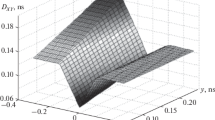Abstract
Accurate modeling of CMOS logic gates for timing and power characterization is a very important task in integrated circuits technology since it facilitates significantly the design phase. Parametric models provide flexibility in determining the circuit performance in various design corners. However, the direct analysis of a complex CMOS gate aiming in an analytical and parametric model is a difficult and cumbersome task. An alternative way to model these gates is by using the equivalent inverter approach. According to this, an inverter with appropriate transistor widths is defined in order to present the same response with the complex gate it models. The challenge with this approach is to propose a simple method to predict the appropriate transistor widths of the equivalent inverter. Then, an analytical model for the CMOS inverter can be used to provide estimates for the complex gates. In this paper, a macro-modeling method is proposed for determining the transistor widths of the equivalent inverter and a technique for providing parametric expressions for these widths in terms of input transition time, output capacitive load, initial transistor width, supply voltage and temperature. A tool is developed to provide timing and power characterizations for the cells of a digital cell library, much faster than conventional numerical circuit simulators. The results prove the efficiency of the equivalent inverter approach in modeling complex gates.













Similar content being viewed by others
Notes
The internal energy consumption is defined as the energy flowing through the power or ground terminal (switching energy \(E_\mathrm{sw}\)) of the driving transistor block (nMOS or pMOS block) minus the dynamic energy (\(E_\mathrm{dyn}\)) which is the energy consumed on the output capacitive load.
Capacitance \(C_\mathrm{o}\) is used in gate characterization to model the total input capacitance of the gate(s) that follow.
References
L. Bisdounis, S. Nikolaidis, O. Koufopavlou, Analytical transient response and propagation delay evaluation of the CMOS inverter for short-channel devices. IEEE J. Solid State Circuits 33(2), 302306 (1998)
P. Chaourani, S. Nikolaidis, A unified CMOS inverter model for planar and FinFET nanoscale technologies, in 17th International Symposium on Design and Diagnostics of Electronic Circuits and Systems, vol. 4 (2014) pp. 242245
P. Chaourani, I. Messaris, N. Fasarakis, M. Ntogramatzi, S. Goudos, S. Nikolaidis, An analytical model for the CMOS inverter, in 2014 24th International Workshop on Power and Timing Modeling, Optimization and Simulation, PATMOS (2014)
A. Chatzigeorgiou, S. Nikolaidis, I. Tsoukalas, A modeling technique for CMOS gates. IEEE Trans. Comput. Aided Des. Integr. Circuits Syst. 18(5), 557–575 (1999)
E. Consoli, G. Giustolisi, G. Palumbo, An accurate ultra-compact I-V model fornanometer MOS transistors with applications on digital circuits. IEEE Trans. Circuits Syst. 59(1), 159–169 (2012)
N.R. Dhanwada, D.J. Hathaway, J. Frenkil, W.R. Davis, H. Demircioglu, Leakage power contributor modeling. IEEE Des. Test Comput. 29, 71–78 (2012)
C. Galani, A. Tsormpatzoglou, P. Chaourani, I. Messaris, S. Nikolaidis, A study for replacing CMOS gates by equivalent inverters, in Proceedings of the IEEE International Symposium on Circuits and System, vol. 2015, July (2015) pp. 18381841
M. Gao, Z. Ye, Y. Peng, Y. Wang, Z. Yu, A comprehensive model for gate delay under process variation and different driving and loading conditions, in Proceedings of the 11th International Symposium on Quality Electronic Design, ISQED (2010) pp. 406412
G. Groeseneken, J.P. Colinge, H.E. Maes, J.C. Alderman, S. Holt, Temperature dependence of threshold voltage in thin-film SOI MOSFETs. IEEE Electron Device Lett. 11(8), 329–331 (1990)
Z. Huang, A. Kurokawa, M. Hashimoto, T. Sato, M. Jiang, Y. Inoue, Modeling the overshooting effect for CMOS inverter delay analysis in nanometer technologies. IEEE Trans. Comput. Aided Des. Integr. Circuits Syst. 29(2), 250–260 (2010)
A. Kabbani, Complex CMOS gate collapsing technique and its application to transient time. J. Circuits Syst. Comput. 19(5), 1025–1040 (2010)
N. Karagiorgos, I. Messaris, M. Ntogramatzi, C. Galani, S. Nikolaidis, Modeling leakage currents of different CMOS cells by the power contributors method, in ACM International Conference Proceeding Series, vol. 0103, October (2015)
I. Messaris, N. Karagiorgos, P. Chaourani, S. Nikolaidis, Static gate power consumption model based on power contributors, in 2014 Conference on Design of Circuits and Integrated Circuits (DCIS) (2014), p. 15
Nangate Inc., FreePDK45 Open Cell Library, Version 1.3 (2009), http://www.si2.org/openeda.si2.org/projects/nangatelib
D. Ntioudis, C. Kalonakis, P. Giannakou, C. Antoniadis, G. Stamoulis, P. Tsompanopoulou, N. Evmorfopoulos, J. Moondanos, G. Dimiriu, CCSOpt: a continuous gate-level resizing tool, in International Conference on Modern Circuits And Systems Technologies (MOCAST) (Thessaloniki, Greece, May 14–15, 2015)
Predictive Technology Model (PTM), 45nm BSIM4 model card for bulk CMOS V1.0 (2006), http://www.eas.asu.edu/ptm/
Synopsys, CCS Timing Technical White Paper, User Manual (2006), p. 115
Author information
Authors and Affiliations
Corresponding author
Additional information
This work was supported by Hellenic Funds and by the European Regional Development Fund (ERDF) under the Hellenic National Strategic Reference Framework (ESPA) 2007–2013, according to Contract No. 11\(\varSigma \varUpsilon N\_5\_719\) project NANOTRIM.
Rights and permissions
About this article
Cite this article
Messaris, I., Galani, C., Ntogramatzi, M. et al. An Evaluation of the Equivalent Inverter Modeling Approach. Circuits Syst Signal Process 37, 2665–2693 (2018). https://doi.org/10.1007/s00034-017-0692-5
Received:
Revised:
Accepted:
Published:
Issue Date:
DOI: https://doi.org/10.1007/s00034-017-0692-5




